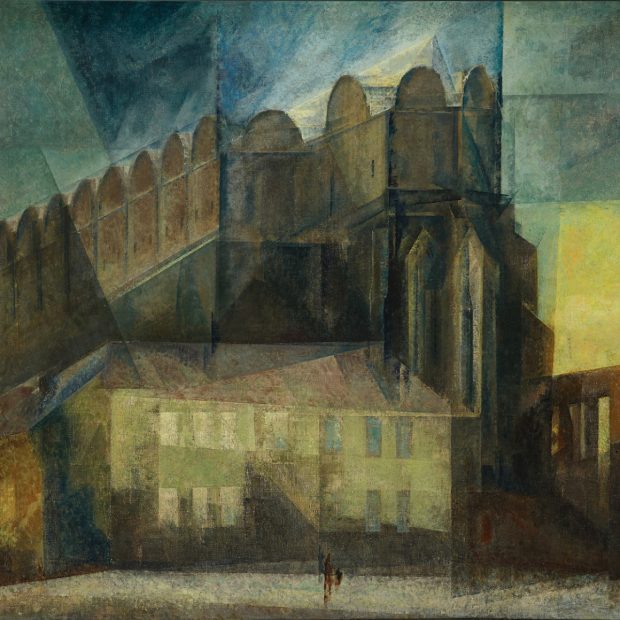
Lyonel Feininger, born in New York on July 17, 1871, loved the idyll – and translated it into an abstract language of forms. The paintings by the Bauhaus teacher, inspired by Thuringian village churches or the Baltic Sea, are part of the canon of modern art.
During his marriage to Clara Fürst in 1901, Lore (1901–1991) and Marianne (1902–1999) were born. In 1907 Feininger married the artist Julia Berg. From this marriage, Andreas (1906–1999), Laurence (1909–1976), and Theodore Lux (1910–2011) emerged.

Der Dom in Halle
From 1905 he turned to printmaking, from 1907 transition to painting. In a few years, Feininger emancipated himself into one of the most important representatives of modernism. In 1913 he exhibited in the “First German Autumn Salon” of the Berlin gallery “Der Sturm” together with artists from the “Blauer Reiter”. His first solo exhibition followed there in 1917.
See also New York: A History of National Colors
Two sailing boats are reflected in the smooth sea in front of an estuary. It’s a hazy day – the sky, sea, and river show myriad variations of gray and blue. Lightbars cut the picture into horizontal, vertical, and diagonal stripes that overlap.
“Rega Estuary III” was created in 1929 when Lyonel Feininger was still a teacher at the Bauhaus in Dessau and traveled with the family to Treptower Deep in West Pomerania, today Mrzeżyno in Poland, every summer. Four years later he is alone there and writes to his wife Julia:
“Could I just convey to you something of the peace, the happiness that is now around me here in the little deep, blessing.”
Feininger sings about a “heaven of Cölinblau”, while his Jewish wife in Berlin is thinking of emigrating. The family had to leave the Masters’ House in Dessau, the Bauhaus was closed. The departure was actually not a problem, because Feininger was an American citizen. He was born in New York on July 17, 1871, and never made an official effort to become German. When Hitler came to power he was 62 years old and tired. He retired to Deep. On this, the art historian Ulrich Luckhardt:
“It was the motives that kept him here in Germany. His entire world of images, the Baltic Sea landscapes, the Thuringian village churches that he has experienced in the sense that they are his universe. And he couldn’t give up that at first.”
Lyonel Feininger came to painting indirectly. After his first art studies, he worked as a cartoonist and was extremely successful. A letter to his future wife Julia from 1905 shows that he was not satisfied with the commissioned work for the press.

Manhattan, Dusk, 1945
“Grotesque thought of being damned to create in eternal travesty; Inside, a heaven of beauty that everyday philistines can never feel like this – any wonder that we from the ‘building’, we caricaturists from inwardness, that we all become melancholy.”
See also 20 Breathtaking Attractions in New York City Every Tourist Must See
Feininger was already a family man at that time. When he met the art student Julia, he left his wife and children and moved to Weimar and later to Berlin. His first paintings show characters derived from his caricatures. After seeing Cubist works for the first time in a Paris exhibition in 1911, Ulrich Luckhardt says:
“Then he also writes that what is seen must be crystallized internally. In other words, what he was actually unable to express informal language as a painter, he somehow already had in mind. That the form has to be shattered, that the pictorial space has to be rearranged. And so this transparent, translucent style gradually developed.”
According to Ulrich Luckhardt, he used traditional methods to realize his vision. During his hiking and cycling tours around Weimar, he made sketches, turned them into black and white compositions with chalk, which he then transferred to the primed canvas. Only then did he pick up paint. He perfected this way of working at the Bauhaus and found recognition in the art world. With his pictures, inspired by places like Gelmeroda, Usedom, or Halle, but characterized by an abstract formal language, he had found his own style.
There was no room for modern art in the ideology of the Nazi state. In 1937 the Feiningers booked a passage to New York. After half a century in Europe, the painter saw his hometown with different eyes. The skyscraper architecture of Manhattan fascinated him, but his “nature notes” – as he called them – from his old world touched his heart.
READ: 20 photos of the beautiful deserts in the UAE
Lyonel Feininger died on January 13, 1956, in New York at the age of 84. His last painting “Evening Haze” shows an evening mood: low gable roofs surrounded by darkness between unreal shimmering haze. His work gained worldwide recognition and is now part of the core inventory of all important picture galleries of modern art.
Like us on Facebook for more stories like this: